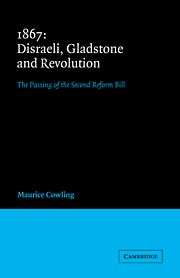Book contents
- Frontmatter
- Contents
- Preface
- Dedication
- Introduction
- I Prelude
- II Preliminary: The uprooting of the Whigs
- III The cornering of the Conservative party
- IV The reassertion of Conservative policy
- V The destruction of Liberal unity
- VI The victory of Disraeli
- VII The public agitation
- VIII The acceptance of Hodgkinson's amendment
- IX Conclusion: Palmerston's mantle
- Epilogue: The limitations of historical knowledge
- Appendixes
- Bibliography
- Notes
- Index
V - The destruction of Liberal unity
Published online by Cambridge University Press: 18 December 2009
- Frontmatter
- Contents
- Preface
- Dedication
- Introduction
- I Prelude
- II Preliminary: The uprooting of the Whigs
- III The cornering of the Conservative party
- IV The reassertion of Conservative policy
- V The destruction of Liberal unity
- VI The victory of Disraeli
- VII The public agitation
- VIII The acceptance of Hodgkinson's amendment
- IX Conclusion: Palmerston's mantle
- Epilogue: The limitations of historical knowledge
- Appendixes
- Bibliography
- Notes
- Index
Summary
‘If the government stand or fall by dual voting, they and their bill are doomed; but I fear, when it comes to the point, they will conform to the Jew's opinion in all things…and yield to [his] arguments for the sake of keeping the party together.’
Sir Rainald Knightley to Cranborne, n.d. [but March 1867]. Salisbury MSSTHE ESTABLISHING OF THE CONSERVATIVE BILL
The policy of March 2 was adopted because no other policy was available, because dependence on the Whigs and the Cave was to be rejected, and because the ‘unenviable and humiliating position’ in which the Conservative party found itself made it seem so ‘contemptible’ that it had to make the bravest show possible. Nevertheless it transformed the situation. The outcome of the events it set in motion was victory over Gladstone, not so much on the second reading of the bill, though that passed without a division on March 26, but in the Tea-Room revolt of April 8, in the withdrawal without a division of the second half of Coleridge's Instruction on going into committee on April 10, and in the defeat of Gladstone's first amendment to clause 3 of the bill on April 12, when the split which had been threatened, and averted, in the Conservative party was carried to the point of actuality in the Liberal party and the Cave. The question we have to ask is: how did this happen?
- Type
- Chapter
- Information
- 1867 Disraeli, Gladstone and RevolutionThe Passing of the Second Reform Bill, pp. 166 - 216Publisher: Cambridge University PressPrint publication year: 1967
- 1
- Cited by



